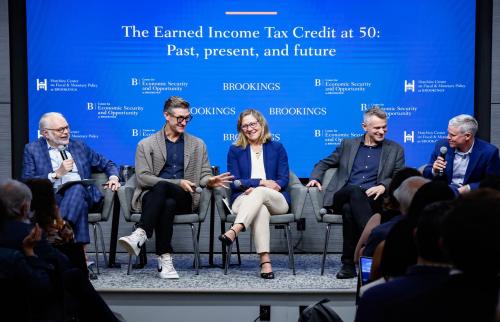It has been a busy year for the Future of the Middle Class Initiative. After launching in May with an event keynoted by Vice President Joe Biden, we defined the middle class, partnered with a team of policy experts to study it, and heard from Governors John Kasich and John Hickenlooper for the release of our own Isabel Sawhill’s new book, The Forgotten Americans: An Economic Agenda for a Divided Nation.
Most important, we have started to dig into the challenges facing the American middle class and those hoping to join its ranks. We found no shortage of policy ideas that should be on the agenda for 2019. (And yes, we are looking at you, 116th U.S. Congress…)
ICYMI, here are the highlights from our most-read pieces of 2018:
1. The inheritance of black poverty: It’s all about the men
Black women born into poverty experience similar rates of upward earnings mobility as white women – but their family income mobility rates are much lower. Importantly, the gap is not explained by differences in family structure. Our results suggest that tackling the strikingly low earnings mobility rates for black men is a necessary step towards breaking the cycle of intergenerational poverty for black Americans.
2. Seven reasons to worry about the American middle class
If you want to know why we started the Future of the Middle Class Initiative, this is the piece to read. We show that the middle class’s wages are stagnating, its prospects are diverging across race and geographic lines, and its confidence in a better future for the next generation is declining. (We also wrote on policy solutions to address these problems—but interestingly, our more optimistic takes didn’t make it to the Top 10 list: a sign of the times perhaps).
3. 40 years ago we stopped the practice of separating American Indian families. Let’s not reverse course.
“If this happens, family separation won’t just be a problem at our southern border and anyone who hopes to avoid repeating America’s past sins should pay attention.”
In a sobering response to a U.S. District Court’s ruling against the Indian Child Welfare Act, our colleague and Rubenstein Fellow Randall Akee explains how backtracking on ICWA could return the U.S. to a not-so-distant past in which American Indian children were removed from their families in alarming numbers.
4. What the forgotten Americans really want—and how to give it to them
 As part of the research for her new book, Isabel Sawhill traveled to three cities to speak with members of the group she calls “the forgotten Americans.” Her essay, based on these conversations, explores the nuances of the forgotten Americans’ economic concerns and cultural values, as well as their attitudes toward the policies Sawhill proposes in her book. One top line: national service is universally popular.
As part of the research for her new book, Isabel Sawhill traveled to three cities to speak with members of the group she calls “the forgotten Americans.” Her essay, based on these conversations, explores the nuances of the forgotten Americans’ economic concerns and cultural values, as well as their attitudes toward the policies Sawhill proposes in her book. One top line: national service is universally popular.
5. Defining the middle class: Cash, credentials, or culture?
There are nearly as many definitions of the middle class as there are researchers studying it. In this paper, we catalogue the many strategies that have been used to define the middle class, from income to occupation to aspirations. The accompanying interactive shows that income-based definitions alone can include households making anywhere from $13,000 to $230,000.
6. The middle class needs a tax cut: Trump didn’t give it to them
Isabel Sawhill and Chris Pulliam show that middle-class income growth has lagged behind growth for the top and bottom quintiles in percentage terms for the last several decades. They urge Congress to repeal and replace the Tax Cuts and Jobs Act.
7. The middle class is becoming race-plural, just like the rest of America
“For more than half a century, the term ‘the American middle-class,’ has served as a political reference to white American upward mobility,” write Camille Busette and Richard Reeves. But that’s less and less true as the middle class becomes more diverse, the authors say.
8. Why are young, educated men working less?
Summarizing a paper by Katharine Abraham and Melissa Kearney, Richard Reeves and Eleanor Krause investigate the finding that employment rates have dropped much more for young men (ages 25-34) than for young women. Part of the difference can be explained by recent trends educational attainment by gender—but the gender gap still emerges among those with college degrees. What’s up with the men, then?
9. Fewer Americans are making more than their parents did—especially if they grew up in the middle class
Unless you spent the year under a rock, you will have likely heard the following statistic from Chetty et al.: Just 50 percent of children born in 1984 earned more than their parents did (adjusted for inflation), down from 90 percent of those born in 1940. Some observers have pointed out that declines in absolute mobility were greatest at the top of the income distribution. We take another look at the data and find that the starting year matters: starting with cohorts born in the 1950s through 1970s (instead of the 1940s), the middle class has suffered the largest declines in absolute mobility.
10. The rise of the middle class safety net
Richard Reeves and Chris Pulliam show that the share of means-tested transfers going to the middle class has more than doubled since 1979. The increasing importance of means-tested transfers as a share of middle-class income raises a question for policymakers: should the U.S. focus on labor market policies to boost income before taxes and transfers, or commit to greater redistribution?
That’s all, folks! Thanks for reading. See you in 2019, and a very Happy New Year.
The Brookings Institution is committed to quality, independence, and impact.
We are supported by a diverse array of funders. In line with our values and policies, each Brookings publication represents the sole views of its author(s).





Commentary
Top ten 2018 reads on the Future of the Middle Class
December 28, 2018
Summaries of the Future of the Middle Class Initiative’s top ten most-read pieces of 2018.